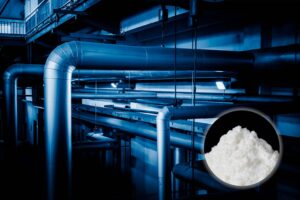Giới thiệu
Dạng muối natri, a versatile chemical compound, has gained attention for its diverse properties and applications across various industries. One intriguing aspect of sodium formate is its potential to replace other chemicals in specific applications. This article delves into the complexitiesof whether sodium formate can indeed serve as a replacement for other chemicals, exploring its advantages, limitations, synergistic effects, challenges, and its role in optimizing processes and enhancing sustainability.
hiểu biết Natri Formate Tính linh hoạt
 Sodium Formate là gì?
Sodium Formate là gì?
Dạng muối natri (HCOONa) is a sodium salt derived from formic acid (HCOOH), known for its water solubility and adaptability. Its unique properties contribute to its relevance in numerous applications.
Advantages of Sodium Formate as a Replacement
1. Environmental Friendliness
Sodium formate is generally considered environmentally friendly compared to some traditional chemicals that may have adverse effects on ecosystems and human health.
2. Versatile Properties
Sodium formate’s ability to act as a buffer, corrosion inhibitor, deicing agent, and more makes it a viable alternative in diverse applications.
3. Cost-Effectiveness
In some cases, sodium formate’s cost-effectiveness compared to other chemicals can be a driving factor for its adoption.
Synergistic Effects and Application Optimization

1. Enhancing Performance
Dạng muối natri can enhance the performance of certain processes when combined with other chemicals, leading to improved results and efficiency.
2. Multi-Functional Applications
Sodium formate’s multi-functional nature allows it to replace multiple chemicals in a single application, streamlining processes and reducing the need for complex formulations.
Limitations and Challenges
1. Application Specificity
Sodium formate’s suitability as a replacement depends on the specific application and the chemical properties required for optimal performance.
2. Compatibility
Compatibility with existing processes, materials, and chemicals must be carefully evaluated before considering sodium formate as a replacement.
Applications of Sodium Formate as a Replacement
1. Deicing Agents
Sodium formate can replace traditional chloride-based deicing agents due to its lower environmental impact and reduced damage to infrastructure.
2. Corrosion Inhibitors
In certain cases, sodium formate can replace other chemicals used as corrosion inhibitors, offering comparable protective properties for metals.
3. pH Adjustments
Sodium formate’s pH buffering capacity allows it to replace other chemicals used for pH adjustments in various processes.
FAQ about Sodium Formate as a Replacement
Q1: Can sodium formate completely replace other chemicals in all applications?
A1: Sodium formate’s ability to replace other chemicals depends on factors such as compatibility, performance requirements, and the specific nature of the application.
Q2: Is sodium formate’s effectiveness as a replacement consistent across all industries?
A2: Sodium formate’s effectiveness varies based on industry requirements and specific processes. It may be more suitable in certain industries or applications.
Q3: What challenges can arise when replacing chemicals with sodium formate?
A3: Challenges may include adapting existing processes, ensuring compatibility with materials, and optimizing formulations for optimal performance.
Q4: How can the decision to replace chemicals with sodium formate be made?
A4: The decision should be based on a thorough assessment of the application, performance requirements, environmental impact, and cost-effectiveness.
Sự kết luận
Sodium formate’s potential to replace other chemicals in specific applications stems from its versatility, environmental friendliness, and multi-functional properties. While it may not be a universal replacement, its advantages, synergistic effects, and compatibility in various processes make it a valuable alternative. By carefully evaluating each application’s requirements and conducting thorough testing, industries can harness the benefits of sodium formate to optimize processes, enhance sustainability, and potentially reduce reliance on more traditional chemicals.


